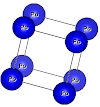Discussion:
(too old to reply)
wanxiang feng
6 years ago
Dear Tran and Blaha,
On theoretical background and practical program code, is it possible
to do scf and bandstructure calculation using mBJ+U(just like the
LDA+U) for some strong correlation system?
If it is feasible, how to determine the U value, is it the same as the
U in LDA+U scheme? Could you give me some literatures about this?
Thank you,
Feng,
On theoretical background and practical program code, is it possible
to do scf and bandstructure calculation using mBJ+U(just like the
LDA+U) for some strong correlation system?
If it is feasible, how to determine the U value, is it the same as the
U in LDA+U scheme? Could you give me some literatures about this?
Thank you,
Feng,
Answer by : F.Tran
In principle, it is possible to run a MBJ+U calculation with WIEN2k,
but the MBJ+U method is probably not a good theory for the following
reasons:
1) In LDA+U (or GGA+U), the exchange part of the double-counting term
is an (rough) approximation to the LDA (or eventually GGA) term.
Therefore, it is maybe not compatible with the MBJ exchange potential.
2) We showed that the band gap and magnetic moment of MnO, NiO, and FeO
are already improved by MBJ, which means that the value of U for the
MBJ+U method should be very small or even zero if the MBJ results are
already ok.
There are several ways to calculate U. Very often, U is adjusted such
that the theoretical results agree with experiment.
but the MBJ+U method is probably not a good theory for the following
reasons:
1) In LDA+U (or GGA+U), the exchange part of the double-counting term
is an (rough) approximation to the LDA (or eventually GGA) term.
Therefore, it is maybe not compatible with the MBJ exchange potential.
2) We showed that the band gap and magnetic moment of MnO, NiO, and FeO
are already improved by MBJ, which means that the value of U for the
MBJ+U method should be very small or even zero if the MBJ results are
already ok.
There are several ways to calculate U. Very often, U is adjusted such
that the theoretical results agree with experiment.
...



![LDA+U+SO: NiO: NaCl structure, A-type AFM along [111]](https://blogger.googleusercontent.com/img/b/R29vZ2xl/AVvXsEgYHT5zuCd3c212SJHBf5vGlUsI5WzUq44G5lOTLURS-f3MTNr_pko0OlCiGzHEEH4MxlbTI4V-9VhBUzvtOQB6TAW3TT0aixEylxH0FkB46PAdmDeoXuYeid9TGNjXmsxGbNEtmyPoAlw/w100/AFM.png)






0 Comments